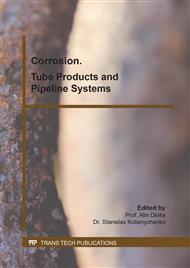p.1230
p.1235
p.1242
p.1251
p.1257
p.1265
p.1270
p.1277
p.1286
Experimental Study on Corrosion of Multi-Component Thermal Fluid Thermal Recovery well Tube String
Abstract:
The thermal recovery well tube string is subjected to corrosion damage in multi-component gas aqueous solution during service period. Some severe damage such as thinning, perforation and even fracture of the pipe can have a serious impact on the stability and safety of the thermal recovery wells. In this paper, the high temperature and high pressure rotating sample reaction device is used to study the corrosion behavior of K55 casing steel and L80 tubing steel in high temperature environment of flowing multi-fluid. The results show the effects of O2 and CO2 concentration and temperature on pipe corrosion. Combining with the results of scanning electron microscope (SEM) and energy dispersive X-ray spectroscopy (EDS) analyses, we inferred the corrosion reaction process of tubes in different media and the corrosion behavior of two kinds of steel in the environment of multiple thermal fluids containing O2 and CO2 is clarified. Results show that the corrosion rates of K55 and L80 increase with the increase of O2 partial pressure and CO2 partial pressure, but the corrosion rates are positively correlated with temperature in oxygen-containing condition and negatively correlated with temperature in carbon dioxide-containing condition. The compactness of the corrosion product film has a large effect on the corrosion rate.
Info:
Periodical:
Pages:
1257-1264
Citation:
Online since:
May 2020
Authors:
Price:
Сopyright:
© 2020 Trans Tech Publications Ltd. All Rights Reserved
Share:
Citation:



